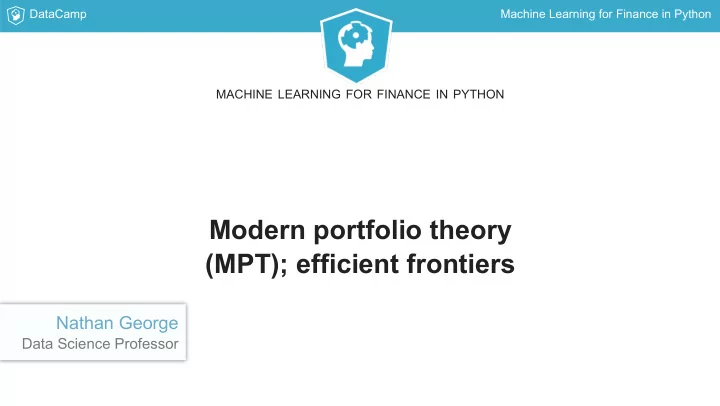

DataCamp Machine Learning for Finance in Python MACHINE LEARNING FOR FINANCE IN PYTHON Modern portfolio theory (MPT); efficient frontiers Nathan George Data Science Professor
DataCamp Machine Learning for Finance in Python
DataCamp Machine Learning for Finance in Python Joining data stocks = ['AMD', 'CHK', 'QQQ'] full_df = pd.concat([amd_df, chk_df, qqq_df], axis=1).dropna() full_df.head() AMD CHK QQQ Date 1999-03-10 8.690 0.904417 45.479603 1999-03-11 8.500 0.951617 45.702324 1999-03-12 8.250 0.951617 44.588720 1999-03-15 8.155 0.951617 45.880501 1999-03-16 8.500 0.951617 46.281398
DataCamp Machine Learning for Finance in Python Calculating returns # calculate daily returns of stocks returns_daily = full_df.pct_change() # resample the full dataframe to monthly timeframe monthly_df = full_df.resample('BMS').first() # calculate monthly returns of the stocks returns_monthly = monthly_df.pct_change().dropna() print(returns_monthly.tail()) AMD CHK QQQ Date 2018-01-01 0.023299 0.002445 0.028022 2018-02-01 0.206740 -0.156098 0.059751 2018-03-01 -0.101887 -0.190751 -0.020719 2018-04-02 -0.199160 0.060714 -0.052971 2018-05-01 0.167891 0.003367 0.046749
DataCamp Machine Learning for Finance in Python Covariances # daily covariance of stocks (for each monthly period) covariances = {} for i in returns_monthly.index: rtd_idx = returns_daily.index # mask daily returns for each month (and year) and calculate covariance mask = (rtd_idx.month == i.month) & (rtd_idx.year == i.year) covariances[i] = returns_daily[mask].cov() print(covariances[i]) AMD CHK QQQ AMD 0.000257 0.000177 0.000068 CHK 0.000177 0.002057 0.000108 QQQ 0.000068 0.000108 0.000051
DataCamp Machine Learning for Finance in Python Generating portfolio weights for date in covariances.keys(): cov = covariances[date] for single_portfolio in range(5000): weights = np.random.random(3) weights /= np.sum(weights)
DataCamp Machine Learning for Finance in Python Calculating returns and volatility portfolio_returns, portfolio_volatility, portfolio_weights = {}, {}, {} # get portfolio performances at each month for date in covariances.keys(): cov = covariances[date] for single_portfolio in range(5000): weights = np.random.random(3) weights /= np.sum(weights) returns = np.dot(weights, returns_monthly.loc[date]) volatility = np.sqrt(np.dot(weights.T, np.dot(cov, weights))) portfolio_returns.setdefault(date, []).append(returns) portfolio_volatility.setdefault(date, []).append(volatility) portfolio_weights.setdefault(date, []).append(weights)
DataCamp Machine Learning for Finance in Python Plotting the efficient frontier date = sorted(covariances.keys())[-1] # plot efficient frontier plt.scatter(x=portfolio_volatility[date], y=portfolio_returns[date], alpha=0.5) plt.xlabel('Volatility') plt.ylabel('Returns') plt.show()
DataCamp Machine Learning for Finance in Python MACHINE LEARNING FOR FINANCE IN PYTHON Calculate MPT portfolios!
DataCamp Machine Learning for Finance in Python MACHINE LEARNING FOR FINANCE IN PYTHON Sharpe ratios; features and targets Nathan George Data Science Professor
DataCamp Machine Learning for Finance in Python
DataCamp Machine Learning for Finance in Python
DataCamp Machine Learning for Finance in Python
DataCamp Machine Learning for Finance in Python Getting our Sharpe ratios # empty dictionaries for sharpe ratios and best sharpe indexes by date sharpe_ratio, max_sharpe_idxs = {}, {} # loop through dates and get sharpe ratio for each portfolio for date in portfolio_returns.keys(): for i, ret in enumerate(portfolio_returns[date]): volatility = portfolio_volatility[date][i] sharpe_ratio.setdefault(date, []).append(ret / volatility) # get the index of the best sharpe ratio for each date max_sharpe_idxs[date] = np.argmax(sharpe_ratio[date])
DataCamp Machine Learning for Finance in Python Create features # calculate exponentially-weighted moving average of daily returns ewma_daily = returns_daily.ewm(span=30).mean() # resample daily returns to first business day of the month ewma_monthly = ewma_daily.resample('BMS').first() # shift ewma 1 month forward ewma_monthly = ewma_monthly.shift(1).dropna()
DataCamp Machine Learning for Finance in Python Calculate features and targets targets, features = [], [] # create features from price history and targets as ideal portfolio for date, ewma in ewma_monthly.iterrows(): # get the index of the best sharpe ratio best_idx = max_sharpe_idxs[date] targets.append(portfolio_weights[date][best_idx]) features.append(ewma) targets = np.array(targets) features = np.array(features)
DataCamp Machine Learning for Finance in Python Re-plot efficient frontier # latest date date = sorted(covariances.keys())[-1] cur_returns = portfolio_returns[date] cur_volatility = portfolio_volatility[date] plt.scatter(x=cur_volatility, y=cur_returns, alpha=0.1, color='blue') best_idx = max_sharpe_idxs[date] plt.scatter(cur_volatility[best_idx], cur_returns[best_idx], marker='x', color='orange') plt.xlabel('Volatility') plt.ylabel('Returns') plt.show()
DataCamp Machine Learning for Finance in Python
DataCamp Machine Learning for Finance in Python MACHINE LEARNING FOR FINANCE IN PYTHON Get Sharpe!
DataCamp Machine Learning for Finance in Python MACHINE LEARNING FOR FINANCE IN PYTHON Machine learning for MPT Nathan George Data Science Professor
DataCamp Machine Learning for Finance in Python Make train and test sets # make train and test features train_size = int(0.8 * features.shape[0]) train_features = features[:train_size] train_targets = targets[:train_size] test_features = features[train_size:] test_targets = targets[train_size:] print(features.shape) (230, 3)
DataCamp Machine Learning for Finance in Python Fit the model from sklearn.ensemble import RandomForestRegressor # fit the model and check scores on train and test rfr = RandomForestRegressor(n_estimators=300, random_state=42) rfr.fit(train_features, train_targets) print(rfr.score(train_features, train_targets)) print(rfr.score(test_features, test_targets)) 0.8382262317599827 0.09504859048985377
DataCamp Machine Learning for Finance in Python Evaluate the model's performance # get predictions from model on train and test test_predictions = rfr.predict(test_features) # calculate and plot returns from our RF predictions and the QQQ returns test_returns = np.sum(returns_monthly.iloc[train_size:] * test_predictions, axis=1) plt.plot(test_returns, label='algo') plt.plot(returns_monthly['QQQ'].iloc[train_size:], label='QQQ') plt.legend() plt.show()
DataCamp Machine Learning for Finance in Python
DataCamp Machine Learning for Finance in Python Calculate hypothetical portfolio cash = 1000 algo_cash = [cash] for r in test_returns: cash *= 1 + r algo_cash.append(cash) # calculate performance for QQQ cash = 1000 # reset cash amount qqq_cash = [cash] for r in returns_monthly['QQQ'].iloc[train_size:]: cash *= 1 + r qqq_cash.append(cash) print('algo returns:', (algo_cash[-1] - algo_cash[0]) / algo_cash[0]) print('QQQ returns:', (qqq_cash[-1] - qqq_cash[0]) / qqq_cash[0]) algo returns: 0.5009443507049591 QQQ returns: 0.5186775933696601
DataCamp Machine Learning for Finance in Python Plot the results plt.plot(algo_cash, label='algo') plt.plot(qqq_cash, label='QQQ') plt.ylabel('$') plt.legend() # show the legend plt.show()
DataCamp Machine Learning for Finance in Python MACHINE LEARNING FOR FINANCE IN PYTHON Train your model!
DataCamp Machine Learning for Finance in Python MACHINE LEARNING FOR FINANCE IN PYTHON Final thoughts Nathan George Data Science Professor
DataCamp Machine Learning for Finance in Python Toy examples Tools for bigger data: Python 3 multiprocessing Dask Spark AWS or other cloud solutions
DataCamp Machine Learning for Finance in Python Get more and better data Data in this course: From Quandl.com/EOD (free subset available) Alternative and other data: satellite images sentiment analysis (e.g. PsychSignal) analyst predictions fundamentals data
DataCamp Machine Learning for Finance in Python MACHINE LEARNING FOR FINANCE IN PYTHON Be careful, and Godspeed!
Recommend
More recommend